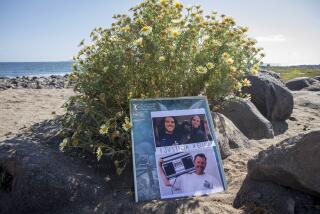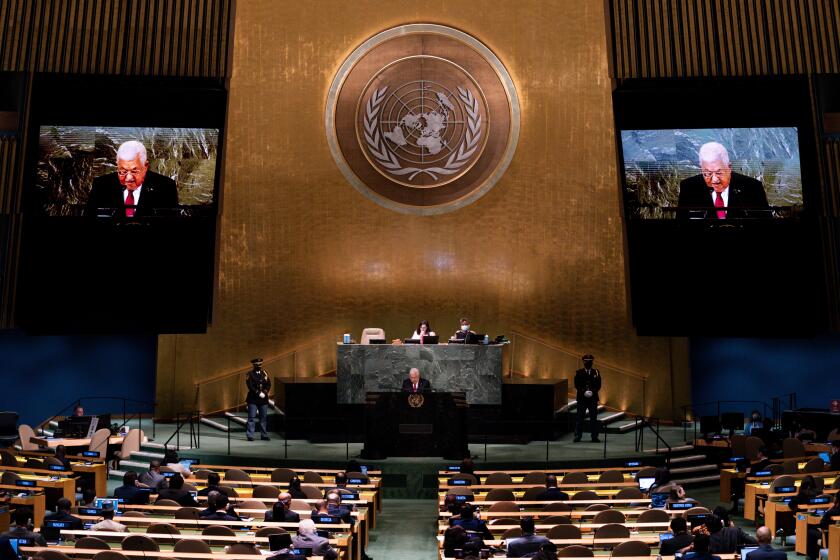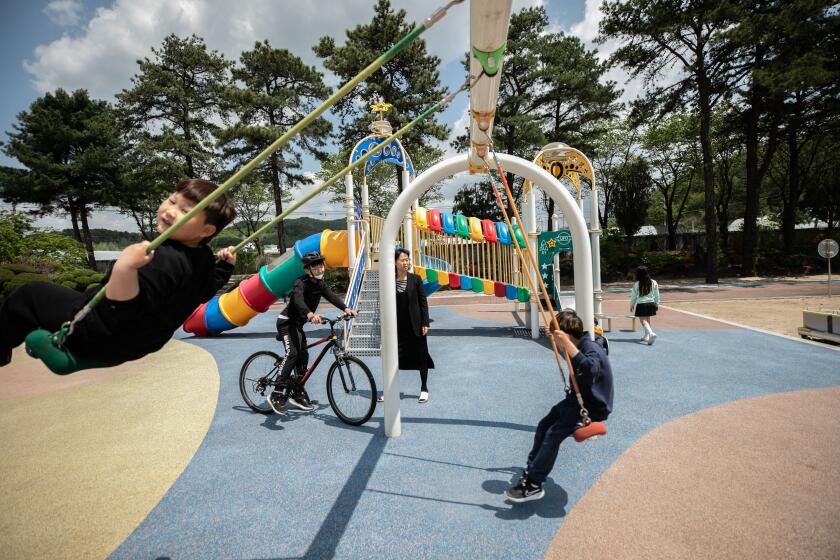Boston’s Courthouse Attempts to Remake the Face of Justice
In a courtroom so modern that jurors “examine” evidence on personal computers, U.S. District Judge Douglas P. Woodlock was fielding tough questions from a demanding audience.
Why did you become a judge? To have the opportunity, every day, to have a hand in justice. Do you know Judge Judy? No! What’s the worst punishment you ever gave someone?
Woodlock fixed his gaze on his interrogator, a 12-year-old girl with beads in her braids. “Ten days ago I had to sentence someone to life imprisonment. He was 33,” the judge said. “It takes years off your life when you hand down a sentence like that.”
Federal judges are not generally known for their warm public manner, so under most circumstances, this session with Boston middle-schoolers would have been an oddity. But under the stewardship of Woodlock and his friend, Stephen G. Breyer, who was chief judge of the 1st Circuit Court of Appeals here before he became a Supreme Court justice, Boston’s new $220-million federal courthouse was designed expressly to make a connection between citizens and their government. With plans in the pipeline for 160 new and renovated courthouses around the country--at $8 billion, the largest federal construction project since the New Deal--officials here are confident that Boston’s 10-story L-shaped building will serve as a model.
Praised by some as a stately temple of justice and damned by others as an impenetrable warehouse by the waterfront, the red brick edifice has jury deliberation rooms with views of the harbor, broad hallways with comfortable seating areas, a park for picnicking, a dock where tall ships anchor--and more public space than any other federal courthouse. So the public will not feel it is interfering with court business, and so defendants have some privacy, architect Henry Cobb of the New York firm of Pei, Cobb, Fried provided three separate traffic circulation systems.
Some government officials slap paintings on the wall and call it an art exhibit. In this courthouse, displays by local artists rotate regularly. They hang not far from a grand rotunda lined with brash, monochromatic panels by painter Ellsworth Kelly. Concerts are held in an airy public zone. When not in use for trials, some of the 27 courtrooms become stages for dramatic portrayals of great legal battles. Community groups hold dinner parties in the atrium, and there are film festivals and seminars.
The design was purposeful: Breyer and Woodlock wanted to reclaim the tradition of the courthouse as community center. More than just a user-friendly federal building, the courthouse was intended to bridge what the judges saw as a disturbing chasm between “us,” the citizens, and “them,” the government.
“I can’t think of a bigger societal problem,” said Breyer, who keeps an office in the courthouse. “It’s hard to attack any problem if the citizens of the United States do not understand that they are the government.”
Half of Americans can’t even name the three branches of government, said District Judge Sandra L. Lynch. In the crush of the computer era, civics classes have been edged off most school curricula, she said.
Ever the optimist, she reasoned: “This might be a good platform for restoring people’s faith in government and reinforcing their sense that the government does belong to them. In more subtle ways, this might address some of the broad issues of anomie that we see.”
Boston is a close-knit city, and where community issues are concerned, its civic and corporate leaders are often responsive. As it happened, the Boston Bar Assn., founded by John Adams, was looking for a public outreach program. With former journalist Maria Karagianis as its director, the group launched the Federal Courthouse Public Education Project as a three-year, $450,000 pilot program.
Karagianis soon brought five of the city’s most blue-blood law firms into the mix. Hale and Dorr, for example, which represented Beatrice Foods in the case depicted in the film “A Civil Action,” had recently undertaken its own $1-million education initiative, in which firm members work directly with city school students. One effort is an apprenticeship, bringing middle-school children into the firm to learn legal terminology, the fundamentals of argument and how a legal case is organized.
Through a nonprofit group called Citizen Schools that marshals corporate volunteers to work with children after school, four other firms had begun similar projects. Karagianis persuaded federal judges to preside next month when the student “lawyers” hold their mock trial competition in the courthouse.
To prepare for the trial, a dozen students crowded into the courthouse elevator one recent school day. The ride itself was a marvel for at least one student, who had never before ridden an elevator. Another voiced surprise that the building seemed so friendly. In his neighborhood of Dorchester, this student said, courthouses are thought of as places where bad things happen.
The students visited the building’s most sophisticated courtroom, where jurors and the judge can consult computers. Then, as they moved to the broad hall that opens onto a seven-story wall of cantilevered glass above the harbor, the students let out a collective gasp.
“I want to live here!” exclaimed Shakeem Barnes, 13.
Beyond the skills they learn in plotting opening or closing arguments, the visits to the courthouse teach students broader lessons than they get in a classroom, said Stepanie Davalos Harden, director of Citizen Schools.
“They need to be emotionally connected, and to visually and viscerally understand our judicial system,” Harden said. “I have seen kids run to that window, with their mouths agape. The light, the height, the beacon. The building says equality, openness, accessibility.”
At the Heart of the Community
The blueprint of citizen involvement is broad, exactly what Breyer and Woodlock hoped for 10 years ago when they set out to plan a courthouse that would resemble something other than an office building, a hospital or, worse, a prison. As students of architecture and history, both judges knew that, along with the town hall, the courthouse traditionally formed the core of small-town America. In generations past, the courthouse was the center of entertainment. People loved to go to trials. Sounding thoughtful, not lofty, Woodlock said, “Courthouses were the places where people engaged in the formative process of American democracy.”
Even today, he said, “a court is the last place in which citizens make important governmental decisions. They do it as jurors.”
As Woodlock and Breyer reviewed proposals for the new courthouse, Cobb’s entry stood out. Known for dignified minimalism, the 72-year-old architect showed the judges pictures of a one-room, 17th century courthouse in Virginia. With “no rigid distinction between the citizens and the government,” Breyer said, it was just what they were aiming for.
“Why not have a jury room that can also serve as a community gathering center?” Breyer asked. “Why not have a day-care center that is attractive? Why not have a building that is part of Boston’s Harbor Walk? Why not have the public space in this building be devoted to something that would interest the public?”
A few grumblers have complained that, with no footbridge over the harbor, the building on the site of an abandoned rail yard is hard to get to. Initially, there was also some quiet concern about turning a place meant for justice into a public theme park and what they would mean for security. But Judge Lynch, for one, responded, “A vital building is probably a safer one.”
Sen. John McCain (R-Ariz.) may have blasted the Boston courthouse as “a Taj Mahal,” but as an early beneficiary of the General Services Administration’s $8-billion courthouse construction and renovation program, the building helped set the standard for the GSA’s Design Excellence Program, in which major architects have been engaged to change the face of federal construction.
But some members of Congress said the GSA plan for design excellence was more like architectural excess. In the federal budgets for 1999 and 2000, no money was requested for courthouse construction. Still, the GSA maintains that courthouse construction remains a priority, noting that by the end of fiscal year 1999, more than $3.7 billion will have been spent since 1991 on more than 40 projects.
Santa Ana’s Ronald Reagan Federal Building opened in January, a year late, but on budget at $123 million. A few weeks ago, the GSA dedicated a $135-million federal courthouse in Sacramento. A new courthouse is under construction in Las Vegas, and one designed by Getty Center architect Richard Meier is in development in Phoenix.
More to Read
Start your day right
Sign up for Essential California for news, features and recommendations from the L.A. Times and beyond in your inbox six days a week.
You may occasionally receive promotional content from the Los Angeles Times.






